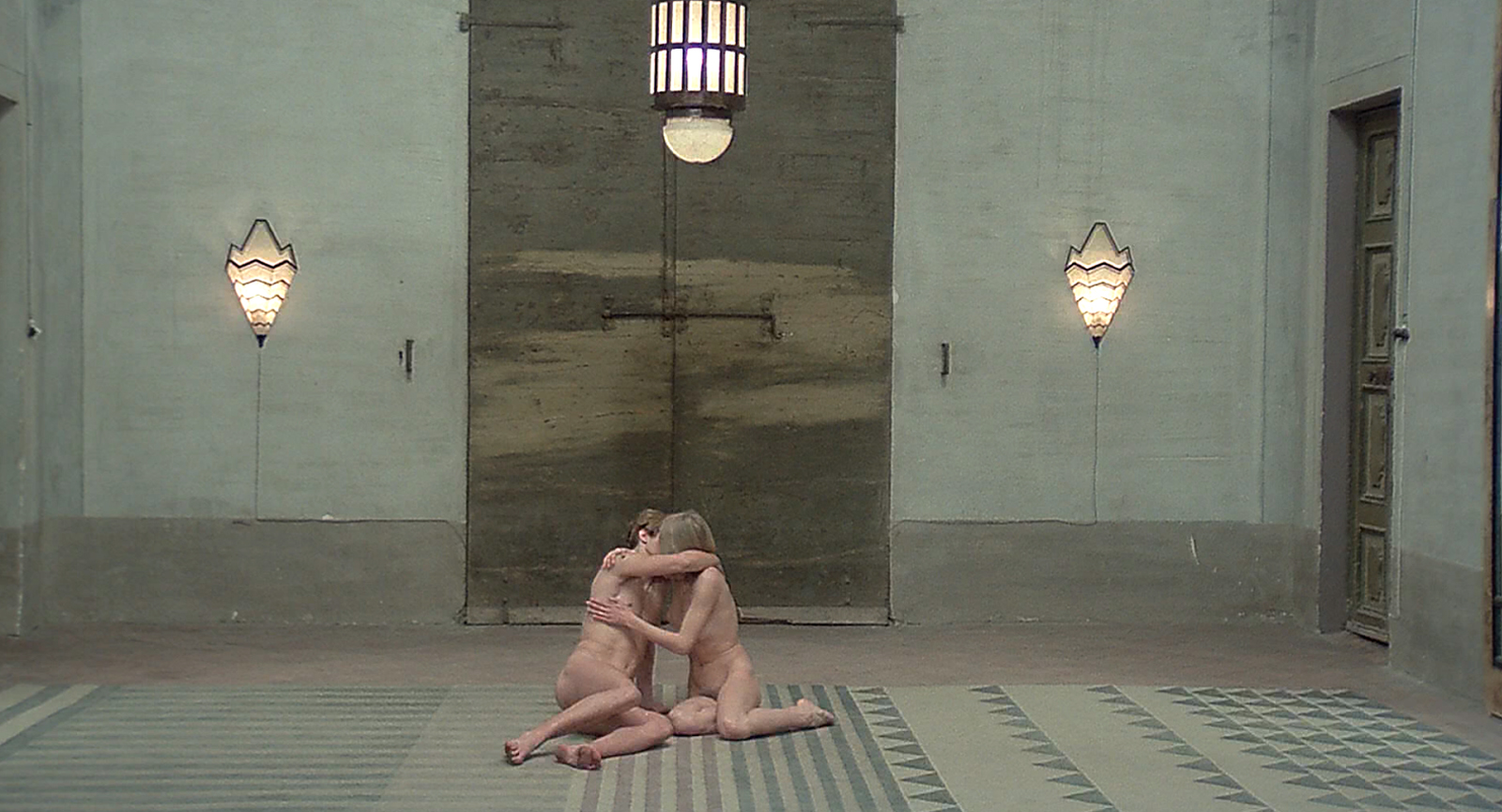I Watched It So You Don't Have To: Salo, or the 120 Days of Sodom
It’s hard to talk about Salo, or the 120 Days of Sodom (1975) without discussing how beautiful it is. In the grand tradition of horrific Italian cinema, Salo is a disgusting, stomach-churning movie that remains stunning even as it dives into the grotesque. Part of that is due to the fact that the majority of the action takes place in a gorgeous palace. That’s not to discredit the actual filmmaking; like the infamous A Serbian Film, Salo is a technically exemplary and lovingly crafted piece of work, and I for one think that aspect was on purpose.
Oscar Wilde once said, “the ugly can be beautiful. The pretty, never.” The sentiment being that ‘prettiness’ is simple and safe, while beauty comes from a riskier place. ‘Beautiful’ can cover the horrific as easily as it can the breathtaking. Think of famous war photos that captured a terrible moment in time. The photos themselves are beautiful even if the subject is the ugliest thing mankind has to offer.
Salo was co-written and directed by Pier Paolo Pasolini, a controversial yet quite learned figure. Pasolini was a poet, writer, filmmaker, political rabble rouser, and intellectual. His career was a strange and often torrid one but many of his works were highly regarded. He worked in the medium of shock with a gracefulness usually lost among the schlocky and the exploitative. He used the extreme to make sharp points and did so without sacrificing style.
As a parable about the rise of fascism in Italy, Salo’s aesthetic beauty gives a disarming sheen to the events that unfold: four aristocratic libertines kidnap 18 youths (nine boys and nine girls, all in their teens) and force them into a whole variety of unspeakable acts. For those who haven’t seen the movie and are wondering what that might mean, I can promise you it doesn’t stop at the obvious duo of torture and sexual abuse. The structure of the movie was lifted from Dante while the meat of it was based off of 120 Days of Sodom by the Marquis de Sade. When the source material is Hell and sadism, you can bet it’s going to get fairly dark. (And how!) For the sake of length, I won’t delve into every piece of insanity this movie covers but rest assured that even the broad strokes are repulsive.
Being that the movie draws on Dante’s Inferno, there are levels of the hell inflicted on the youths, referred to as “sons and daughters” throughout, to make it extra unsettling. The aristocrats hire four older prostitutes to help out with their bizarre game. We see them throughout the rest of the movie in varying capacities but always aware of what’s happening and always egging the aristocrats on through the levels. There’s the Circle of Manias, Circle of Shit, and the Circle of Blood. How much we’ll delve into each of these circles will depend on how closely I was able to pay attention during my initial watch and subsequent re-watches. Circle of Shit’s gonna be pretty vague.
Circle of Manias features lots of fondling, rape, and weird rituals. The daughters are forced to serve food naked where one is tripped and raped by a soldier. In the oddest “show us on the doll moment” I’ve ever seen, all the youths are shown via a mannequin how to masturbate a penis. Then there’s a duke receiving (yes, receiving) anal sex while singing, and the forced marriage of two of the poor kids who are then raped to keep them from having sex with each other. Up to this point, the violence has been in the realm of sexual, and aside from the discovery of the murdered body of a daughter that attempted escape, there’s nothing going on that seems to threaten the kids’ lives. Until, that is, they are all paraded around like dogs on leashes and fed food with nails in it. One of the daughters rears up from the floor with a shout, and we see blood pouring from her mouth. Right around here is where it really starts to get wild.
Circle of Shit is the worst part of this movie. I’ve seen this film a handful of times and have sat attentively through the Circle of Shit twice. Each time I do see it, it takes a few days to really get some of the images from it out of my head. Who are we kidding? We all know those images are there forever. Rewatching something revives them but it doesn’t implant them. I will think of Circle of Shit at inopportune times and find myself gagging. Let’s get into it then: you can probably imagine some of what goes on in this circle, and it involves a lot of people eating fecal matter. The sons and daughters are ordered not to defecate on their own and save it up for the big feast. Since they’re forced to relieve themselves in bedpans, it becomes easy for the prostitutes who act as their wards to check on them. One girl is beaten after being unable to control her bowels, and the scene of her standing naked with a bedpan and one snake of shit in gets the gag reflex going. But that’s, of course, just the start.
The prostitutes regale everyone with stories of their messed up childhoods and clients eating their shit, which they refer to as a delicacy. The sons and daughters are all forced into partaking, and it’s pretty clear that none of them are having a good time. After the feast, one of the boys is led away by his “owner” whose mouth is covered in brown stains. He kisses the boy in what looks to be the most unwanted, unsavory kiss any of us have ever witnessed.
There’s also a scene of psychological torture where the aristocrats have a bet about which among their “sons and daughters” has the best ass (See, Italy? Ya made it weird). Once the bet is settled, the “winner” of the contest has a gun held to his head and is told he’s going to be executed. The trigger is pulled but it’s only blanks. A beautiful piece of acting follows as we see the young man’s face flood with relief then return to a state of dread. Dying at that point in this whole scheme would have been preferable.
Circle of blood is infinitely better. It’s horrific, and it’s where the tortured sons and daughters meet an insanely grizzly end but it’s less disgusting (in my opinion at least). This is also the circle where the commentary is most obvious. The youths betray each others confidence and tell the aristocrats all the secrets they know. Some are having affairs, one is hiding a photograph she’s not supposed to have. A collaborator Enzio gets ratted out for having an affair with a black servant and is shot with his hand raised in a Socialist salute. One of the daughters is spared the final step because she provided enough information. The others are sentenced to “a painful death.” We, as the audience, join the aristocrats who view the executions from windows above a courtyard.
The deaths are gruesome and graphic, and the victims spend their last moments cowering together and crying in fear. That’s not the image we end on though – for this movie to really upset us now it has to pull out all the stops, right? After we see eyes gouged, tongues cut out, burning, hanging, and scalping, Pasolini ends this fucking thing with two soldiers who were witnesses to everything dancing a waltz together and asking about each other’s girlfriends back home.
So what did we all learn? Well, unlike some extreme movies, this one had a lot to say and did so in a startling but effective way. We tend to think of Fascism as everyone “agreeing” to the same ideals, but there seems to be nothing to that effect even mentioned. Instead of a commentary on what fascism does, Salo presents what it allows for. It’s about abuses of power and of people feeling themselves justified in everything they do; the aristocrats show no remorse or even the slightest hesitation, they treat everyone as if they are in their employ and at their disposal, regardless of status. They alone are the deciders of right and wrong in the carnival they created, and while everyone else is expected to answer to them, they feel no need to return that consideration. They make rules out of thin air then harshly punish anyone who breaks them, knowingly or not.
The last act in the movie, where the youths betray each other and their sentences are passed down, points to the paranoia that inevitably takes over within any type of regime. The sons and daughters have been going through this together but when given a chance to spare themselves, they turn on each other. The admitted offenses are mild, even non-existent in a sane world, but under the rules imposed they’re worthy of a painful death. Beneath an iron fist, all bugs are crushed evenly. There is no distinction between an offense of lying or an offense of carnality; everything leads to demise.
Salo is a beautiful piece of work. Plenty of people hate it passionately but just as many people love it. It’s obvious how frightened Pasolini was for the future of his country and possibly the world. The last shot with the two young soldiers dancing are the most obvious manifestations of his fear: not browbeaten and turning to the party for survival but being there because they want to be. The power structure protects them, so who cares about a few others? We can understand that fear quite well nowadays, where people enthusiastically line up with rigid ideologies and unilaterally proclaim themselves as correct. The fascism in Salo may be from another era, a different struggle, but it rings true for today. This makes it as upsetting and important as it was when it first came out, if not more so.








